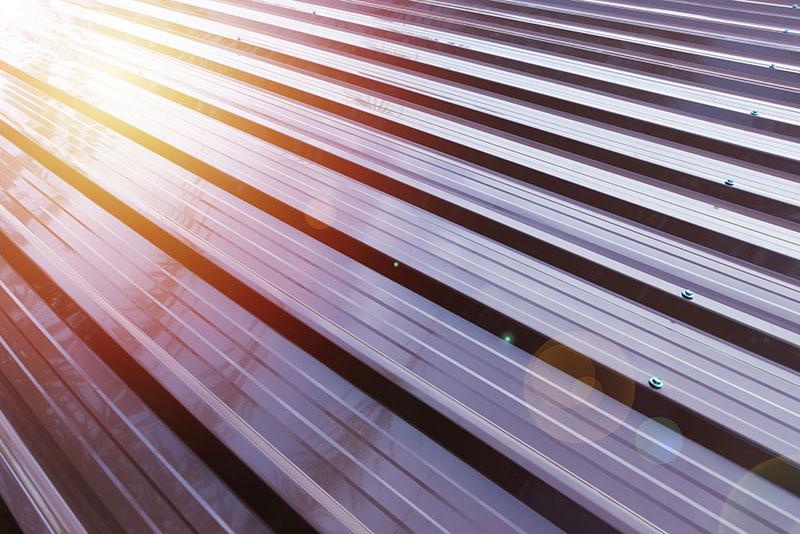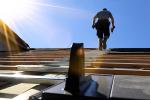Reflectivity, Reflectance and Glare

This is a review and update of an article published in Scope 10 years ago. We then produced two technical articles about Solar Reflectance and Thermal Emittance and the relationship between the apparent visual colour of a metal roof and its ability to absorb or not absorb heat. The way in which these visual factors can be modified by the use of “cool pigments” to allow the use of darker colours while reducing heat gain was also covered.
In 2023 it seems that this is again a topic of interest/concern, and indeed quite recently I was struck (almost literally) by the quite blinding glare from a new unpainted Zincalume ® roof on the skyline, seen at just the wrong angle. How much heat is a concern in New Zealand is not clear, and we notice a current preponderance of dark and even black roofs, which suggests that this is not an issue.
Glare
Over the years there has been much talk of glare and “reflectivity” and “reflectance” with the two latter terms being used more or less interchangeably.
We now find “Solar reflectance” which is defined as the ratio between the solar energy globally reflected by a surface and the total incident solar energy. Traditionally, roofing materials’ SR can be between 0.05 and 0.5 (e.g., 0.05 for black membrane roofs, 0.08–0.5 for metal roofs, and 0.2 for clay tiles). So this is to do with heat as well as light. Confusingly we then have the “Solar Reflectance Index (SRI)” which is the measure of solar reflectance and thermal emissivity of materials. Solar reflectance or reflectivity is the ability of a material to reflect solar energy from its surface into the atmosphere.
And then we also have “Total Solar Reflectance (TSR)” measures the amount of solar energy across the entire spectrum that is reflected away from an object. This correlates closely to the temperature that the object will reach on a hot summer’s day. Light Reflectance Value (LRV) on the other hand, focuses solely on the total quantity of visible light that is reflected by a surface in all directions and at all wavelengths.
So we could say that “Glare” is measured by LRV and heat gain or loss by TSR and SRI measures both. Glare seems to be more of a concern in New Zealand than heat gain.
Various dictionaries define glare as “To shine with or reflect a very harsh, bright, dazzling light”. Motorists who drive in the morning or evening (like nearly all of us) will have at one time or another been nearly blinded by incoming direct or reflected sunlight straight into their eyes, not necessarily from a roof. The TipTop icecream factory was at an earlier time notorious for creating blinding reflections on the Auckland Motorway at Mount Wellington, although this seems to have been mitigated by the use of different glazing.
The glare from house roofs has also long been an issue ranging from annoyance to serious eyesore and BCAs in New Zealand have been proactive in trying to prevent this, particularly in rural areas. Queenstown Lakes District Council even specifies acceptable colours, and limits “reflectance”.
From the QLDC District Plan, and “The reflectance of the surface of a material is its effectiveness in reflecting radiant energy. For homogeneous and semi-infinite materials, reflectivity is the same as reflectance.” Wikipedia. Measured with a reflectance spectrophotometer.
Bluescope in their bulletin about glare suggest that this is only an issue at certain angles and at a single point in time of year. While this may be true for maximum glare it is also true that unpainted steel roofs and light coloured painted roofs can cause visual glare issues for years at any time when the sun hits at a shallow angle. This would apply beyond just a fixed viewpoint and view angle.
It is true that driving past a building with a “shiny” roof the glare changes by time of day and angle of incidence.
Heat Gain
Internationally the emphasis has over time shifted somewhat from glare reduction (minimum reflection of visible light) to “cool roofs” where the cost of air conditioning for cooling can be reduced by roofs which have minimum thermal gain (maximum reflection of IR radiation) and maximum thermal emissivity. It seems likely that this concern will increase as global warming proceeds. In New Zealand this seems less of an issue with a large number of dark or even black roofs being installed. This is probably a fashion stimulated pattern, but maybe also this is because of better internal insulation; either way it still means much heat being re-radiated into the atmosphere – and adds to global warming.
Glare reduction and low heat gain (i.e. less glare and less heat) are mutually incompatible. Surfaces which reflect IR normally reflect visible light as well and so minimum heat gain/maximum heat loss will probably result in higher glare. We can see this in the extreme heat gain in the Arctic Ocean, where premature loss of high-albedo ice early in the year is causing temperatures to increase even more than elsewhere in the world.
The use of “cool pigments” which has been promoted as a feature of some dark colours, can offset this to some extent by allowing reflection and emission at one level in the IR part of the light spectrum and to a lesser degree in the visible part of the spectrum. Many roof paints today claim to use “cool pigments”, although such pigments have been used for decades without being called “cool” because they are also more cost effective and durable.
In the New Zealand environment preventing thermal gain/maximising thermal emission seems not to be seen as particularly important at present. There is also a difference between a house with a space and then insulation separating the roof cladding from the inside and commercial buildings where typically the roof cladding (plus foil/underlay etc) are directly exposed to the internal building space and can radiate heat into this space. If you believe advertisements for ventilation systems claiming to extract heat from the roof space, it would seem that getting hot is useful, so for domestic roofs more thermal gain may be beneficial in reducing heating costs, although the numbers derived from the thermodynamics don’t really bear this out. When MRM have looked at potential benefits from heat gain into buildings from the roof, there seems little real movement either way.
“Glare”, however defined, continues to be undesirable in many visual environments.
In NZ while there are some attempts to promote “cool roofing” or White Roofs as environmentally friendly this is debateable in the current heating/cooling building environment, and avoiding glare is more important in many locations. Some BCAs are making this a point of issuing consents.
What is “low glare”?
To some extent this is in the eye of the beholder, but there is a test method for reflectivity which can be used – ASTM E903-96. The Queenstown BCA guideline implies “reflectance” of 0-20% as best, 21-35% as acceptable and over 35% as unacceptable. The Queenstown guide also says that materials with non-shiny, textured or matt/powder finish are preferable.
Which leads to another measurement that is applicable to visual glare (but not to thermal reflection), which is gloss, and a Sheen Gloss meter can be used to determine the “glossiness” of roofing materials.
We have previously considered mainly long run metal roofing, but in fact there are other roofing materials which need to be considered once we are looking at houses, rather than commercial buildings. Metal tiles which are also part of NZMRM’s range, and concrete tiles, clay tiles, asphalt shingles and built up roofing all have their own properties.
The following qualitative diagram shows the relationship between the three properties of Colour, Gloss, and Texture and Glare/Heat gain.
Gloss (60° Sheen Gloss) figures for various products that we are aware of are –
Textured metal tiles – zero
Satin metal tiles (post painted) – 4-8%
Low gloss coil-coated painted– 10-15%
New Zincalume 20-25%
Standard coil-coated painted – 25-30%
Clearly, where glare is seen to be an issue, standard gloss coil-coated product of light colours are likely to be worse. Unpainted Zincalume with its very light colour and quite high initial gloss may be worse, but it does weather down. Dark coloured textured tiles are likely to be the best with no glare at all.
New concrete tiles normally have a high gloss acrylic coating, and asphalt shingles use flat granules, which would be similar to but slightly less effective than textured tiles. Unglazed clay tiles should have low glare, but a noticeable colour.
It would be necessary to do some testing to ASTM E903-96 and using Sheen Gloss of all materials in various colours to get a definitive quantitative statement, but in general – post-painted metal tiles (textured or satin) are better in reducing glare than roofing made from any pre-painted coil. This is unrelated to colour from a gloss point of view, although darker pre-painted colours will have less visual impact.
Trade-off between glare and heat gain
The diagram shows clearly that for unmodified products the two properties are in opposition – highest glare has least heat gain, and vice versa. The heat gain factor for darker coloured finishes may be mitigated by the use of “cool pigments” which are said to be reflective in the IR (heat) more than in the visible part of the spectrum and so allow the use of darker colours (to reduce glare) without as much heat gain as using standard pigments.
From the above the most obvious way to minimise glare in sensitive locations is to use dark coloured textured chip metal tiles. Use of cool pigments could allow use of darker coloured painted metal roofing.
Mitigation of:
Glare
1) Minimise by use of low-gloss, textured dark colours with lower “Reflectance”. The Queenstown Lakes district plan quoted above covers this
2) Reduction of visible glare by adjustment of the location/screening. The Bluescope Technical Bulletin TB-28 deals with this method.
3) Use of cool pigments allowing darker colours with less heat gain.
4) Use of glass covered solar panels (either thermal or pv) or skylights may create spots of high glare in an otherwise low-glare roof, and pv coating/laminate will be better for glare.
Heat
1) Under roof (eave to ridge) ventilation.
Oak Ridge National Laboratory in the US has done work on under roof ventilation of metal tiles as reported in the Decra Green Brochure, which shows that under-roof ventilation for metal tiles (and presumably other materials) is significantly better at reducing heat gain than any colour modification. “The study concluded that there is a potential trade-off between solar reflectance and over the deck venting when modelling for energy efficiency; “venting of the stone-coated metal
roofs is just as important as the solar reflectance for reducing the heat gain into the attic
and conditioned space.”
2) Earlier research done by NZMRM was not able to show significant heat gain or loss from long-run metal roofs installed in the normal way.
Conclusion
Minimum Glare from domestic roofs can be achieved by using dark coloured textured metal tiles. A good result is from using medium to dark post-painted metal tiles. Darker coloured or “matt finish” long-run roofing is better than light colours or bare metal.
Heat gain from using darker products on domestic roofs is likely to be minimal and not thought important in New Zealand houses. If heat gain is thought to be an issue the use of “cool pigments” may reduce it and under-roof ventilation has been shown to be effective.
Stuart Hayman June 2013 Updated July 2023

